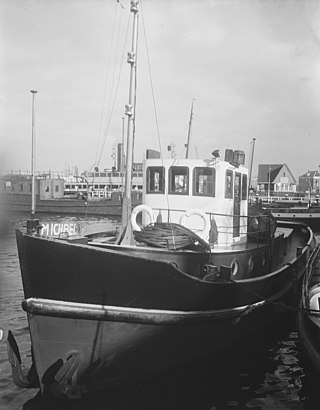USS Autauga (AK-160) was an Alamosa-class cargo ship commissioned by the US Navy for service in World War II. She was responsible for delivering troops, goods and equipment to locations in the war zone.

USS Beaverhead (AK-161) was an Alamosa-class cargo ship commissioned by the U.S. Navy for service in World War II. She was responsible for delivering troops, goods and equipment to locations in the war zone.
USS Blount (AK-163) was an Alamosa-class cargo ship commissioned by the U.S. Navy for service in World War II. She was responsible for delivering troops, goods and equipment to locations in the war zone.

USS Chatham (AK-169) was an Alamosa-class cargo ship commissioned by the U.S. Navy for service in World War II. She was responsible for delivering troops, goods and equipment to locations in the war zone.
SS Saint Boswells, also written as SS St. Boswells, was a 463 GRT tug built in 1919 for the British Royal Navy. While towing SS Santa Therasa in June 1920 she struck a naval mine near Terschelling, the Netherlands and sank immediately. 16 people were killed in the disaster. Six people were rescued, one of them was injured.
SS Ajax was a cargo steamship that was built in Germany in 1923 as Elbe. In 1927 she was renamed twice, first to Ceuta and then to Ajax.

Royal Rotterdam Lloyd was a Dutch shipping line that was established in Rotterdam in 1883 as Rotterdamsche Lloyd (RL). It became "Royal Rotterdam Lloyd" in 1947. RL mainly operated scheduled passenger and mail services between Rotterdam and the Dutch East Indies. Its independent existence ended in 1970, when KRL merged with four other Dutch shipping companies to form the Nederlandsche Scheepvaart Unie (NSU). In 1977 NSU became Nedlloyd.

HNLMS Orkaan (A837) was a tugboat of the Royal Netherlands Navy (RNN). She served in the RNN between 1949 and 1961. It was at the time the largest tugboat to be built in the Netherlands for the RNN.
PS Jan van Arkel II was a Dutch passengers paddle steamer of the Gorinchemsche Schiedamsche Stoomboot-maatschappij built by Fop Smit and launched on 8 March 1847. The ship was used for the 's-Hertogenbosch—Gorinchem—Schiedam line.
Laurdal was a Norwegian barque in the 19th century.
SS Octa was a 1861 built British steamship. The ship had a tonnage of 569 gross register tons (GRT). It was owned by Norwood C. M. & Co. in Hull. On 1 May 1871 the ship was driven ashore and wrecked on Terschelling, the Netherlands. The 19 crew members were rescued.
SS Vidar was a 1873-built, 60-metre -long Swedish steamship. It was owned by shipping company Ang Fartyg and was registered in Gothenburg. On 20 September 1875 the ship was driven ashore and wrecked on Terschelling, the Netherlands. The crew members were rescued.
SS Anna Paulowna was a 1857 built 63 metres long Dutch steamship. It was owned by Koninklijke Nederlandse Stoomboot-Maatschappij (KNSM) and had hometown Amsterdam.
Lisette was an 1881-built, 50-metre long German three-masted iron schooner. It was owned by Johan Georg Oestman and had hometown Blankenese.
Horstendaal, also written as Horftendaal and Horstendael, was an 18th-century East Indiaman of the Dutch East India Company.
SS Council Bluffs was a 1918-built, 77.1 metres long American cargo steamship. It was built by Great Lakes Engineering Works and owned by United States Shipping Board. During the morning of 13 November 1919, the ship sank by a mine near Terschelling, the Netherlands. The wreck of the ship was found in 1993.
SS West Aleta was a 142 metre long American Design 1019 cargo steamship with home port San Francisco. She was built in 1919 by Western Pipe and Steel Company, and owned by United States Shipping Board. During a storm on her maiden voyage on 12 February 1920, the ship sank near Terschelling, the Netherlands. All 42 crew members were rescued. The salvage of the ship was difficult and took almost a year.
MV Baden, also renamed into MV Sambi and MV Aden, was an 1966 Norwegian built coastal trading vessel. The ship was later sailing under the flag of Panama (1982–1985) and Honduras (1985–1988). On 26 February 1988 the ship sank near Texel, the Netherlands, after the ship tilted due to shifting cargo. All crew members survived by sprinting into the water. Criticism of the rescue operation followed.
SS Margariti, originally named SS Wearwood and later also SS Carita and SS Harrow, was a 1930 British built cargo ship of the Constantine Group. It was later owned by British Galbraith, Pembroke & Co., Swedish Manne J. E. and from 1962 by Greek Sigalas & Platis Bros under Lebanese flag. On 18 October 1967 while en route from Gdansk, Poland to Tartous the ship sank near Ameland, the Netherlands, after the ship tilted due to shifting cargo during a gale. All 24 people on board were rescued.
MV Lady Odiel, often written as MV Lady Odile, originally named MV Kalmarsund IX and later also renamed into MV Jomfruland, was a Swedish-built 487 GRT cargo ship in 1957 for Swedish company Angbats A/B Kalmarsund.. She was acquired in 1964 by Swedish Andersson, AE, Rönnäng and later in 1981 by the British Odiel Shipping Company.



